brake light MERCEDES-BENZ E-Class CABRIOLET 2013 C207 Owner's Manual
[x] Cancel search | Manufacturer: MERCEDES-BENZ, Model Year: 2013, Model line: E-Class CABRIOLET, Model: MERCEDES-BENZ E-Class CABRIOLET 2013 C207Pages: 372, PDF Size: 12.69 MB
Page 6 of 372
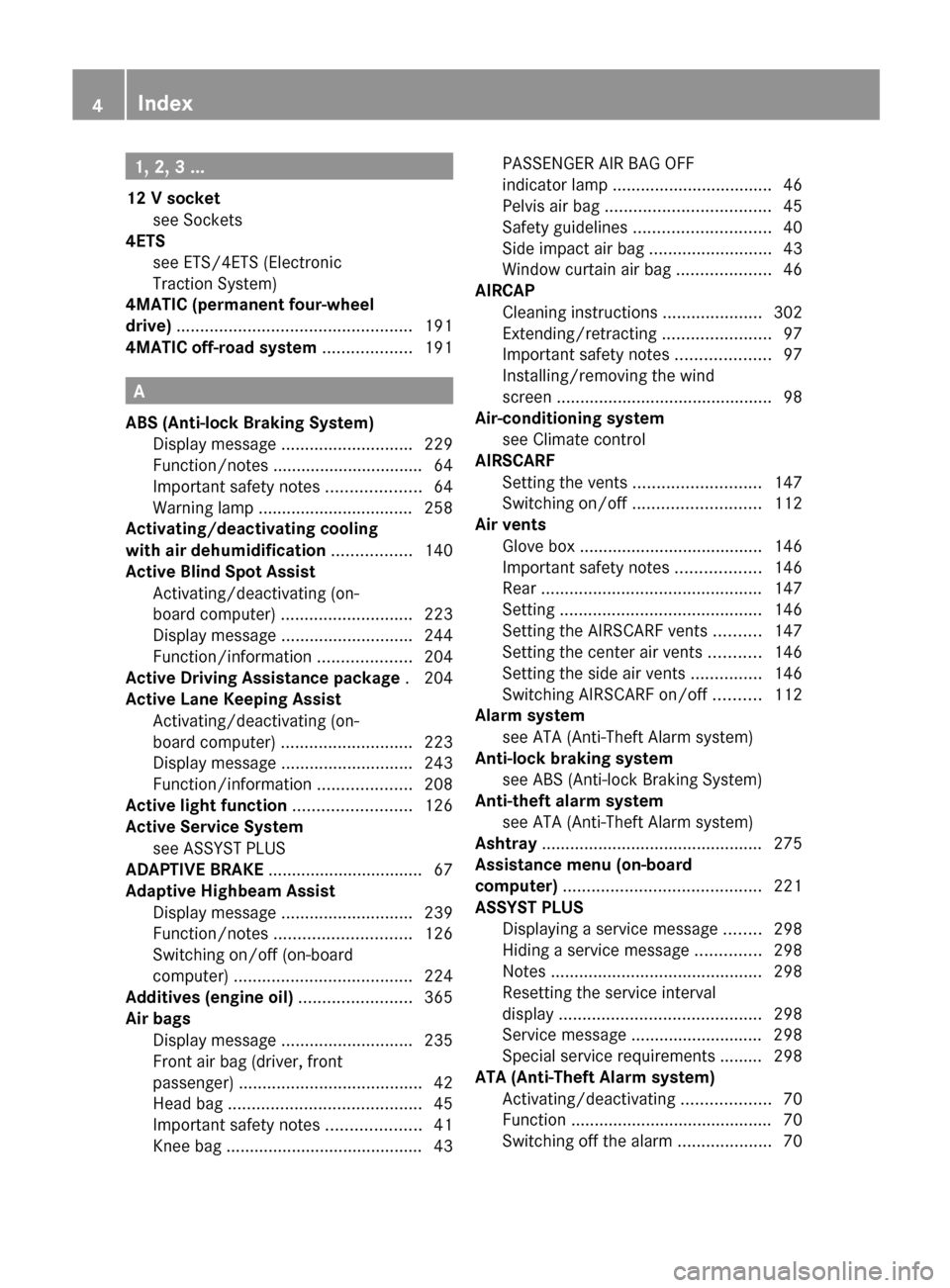
1, 2, 3 ...
12 V socket see Sockets
4ETS
see ETS/4ETS (Electronic
Traction System)
4MATIC (permanent four-wheel
drive) .................................................. 191
4MATIC off-road system ................... 191A
ABS (Anti-lock Braking System) Display message
............................ 229
Function/notes ................................ 64
Important safety notes .................... 64
Warning lamp ................................. 258
Activating/deactivating cooling
with air dehumidification ................. 140
Active Blind Spot Assist Activating/deactivating (on-
board computer) ............................ 223
Display message ............................ 244
Function/information .................... 204
Active Driving Assistance package . 204
Active Lane Keeping Assist Activating/deactivating (on-
board computer) ............................ 223
Display message ............................ 243
Function/information .................... 208
Active light function .........................126
Active Service System see ASSYST PLUS
ADAPTIVE BRAKE ................................. 67
Adaptive Highbeam Assist Display message ............................ 239
Function/notes ............................. 126
Switching on/off (on-board
computer) ...................................... 224
Additives (engine oil) ........................365
Air bags Display message ............................ 235
Front air bag (driver, front
passenger) ....................................... 42
Head bag ......................................... 45
Important safety notes .................... 41
Knee bag .......................................... 43 PASSENGER AIR BAG OFF
indicator lamp
.................................. 46
Pelvis air bag
................................... 45
Safety guidelines ............................. 40
Side impact air bag .......................... 43
Window curtain air bag ....................46
AIRCAP
Cleaning instructions ..................... 302
Extending/retracting .......................97
Important safety notes .................... 97
Installing/removing the wind
screen .............................................. 98
Air-conditioning system
see Climate control
AIRSCARF
Setting the vents ........................... 147
Switching on/off ........................... 112
Air vents
Glove box ....................................... 146
Important safety notes .................. 146
Rear ............................................... 147
Setting ........................................... 146
Setting the AIRSCARF vents ..........147
Setting the center air vents ...........146
Setting the side air vents ............... 146
Switching AIRSCARF on/off ..........112
Alarm system
see ATA (Anti-Theft Alarm system)
Anti-lock braking system
see ABS (Anti-lock Braking System)
Anti-theft alarm system
see ATA (Anti-Theft Alarm system)
Ashtray ............................................... 275
Assistance menu (on-board
computer) .......................................... 221
ASSYST PLUS Displaying a service message ........ 298
Hiding a service message .............. 298
Notes ............................................. 298
Resetting the service interval
display ........................................... 298
Service message ............................ 298
Special service requirements ......... 298
ATA (Anti-Theft Alarm system)
Activating/deactivating ................... 70
Function ........................................... 70
Switching off the alarm .................... 704
Index
Page 7 of 372
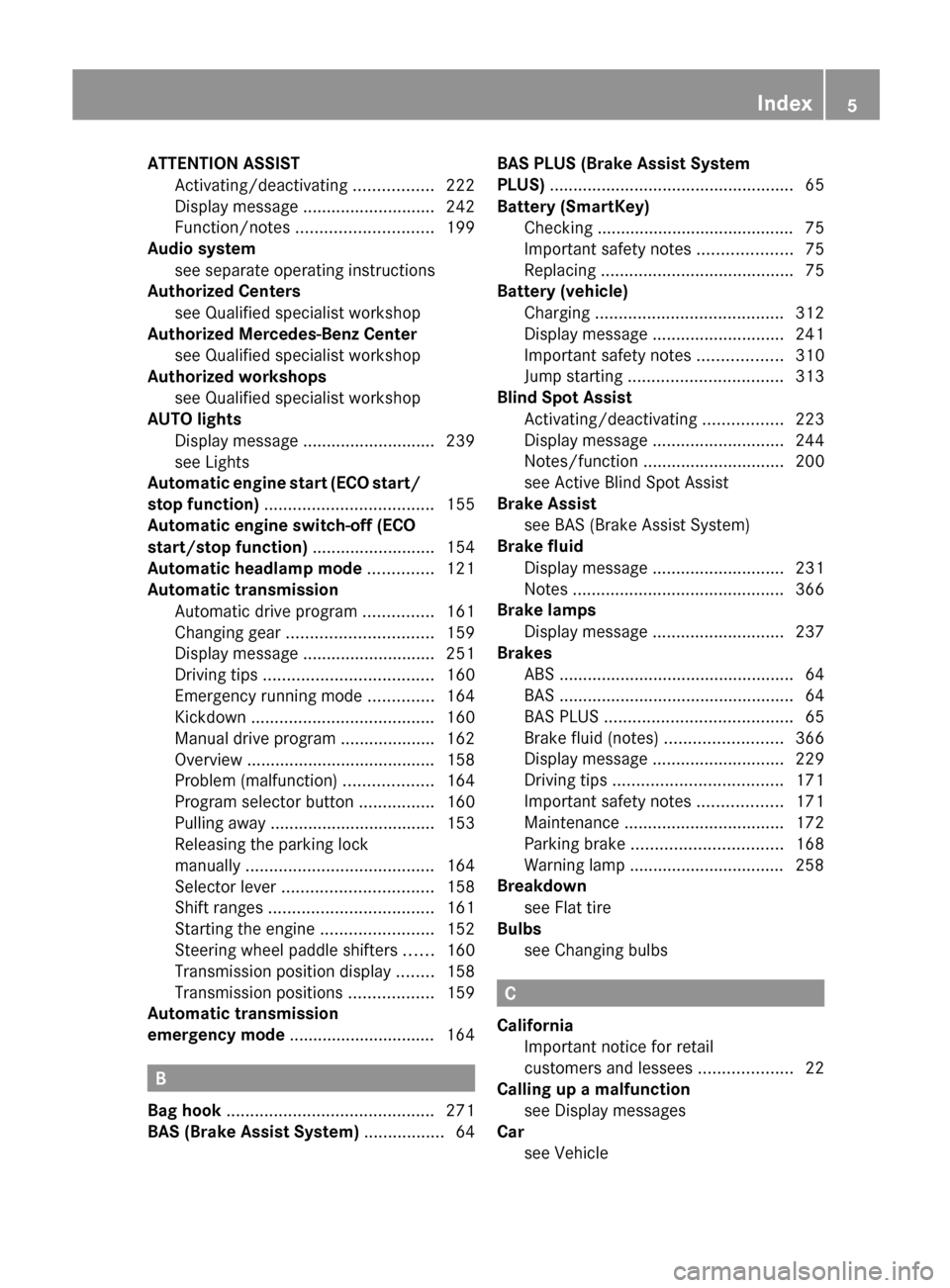
ATTENTION ASSIST
Activating/deactivating .................222
Display message ............................ 242
Function/notes ............................. 199
Audio system
see separate operating instructions
Authorized Centers
see Qualified specialist workshop
Authorized Mercedes-Benz Center
see Qualified specialist workshop
Authorized workshops
see Qualified specialist workshop
AUTO lights
Display message ............................ 239
see Lights
Automatic engine start (ECO start/
stop function) .................................... 155
Automatic engine switch-off (ECO
start/stop function) .......................... 154
Automatic headlamp mode ..............121
Automatic transmission Automatic drive program ............... 161
Changing gear ............................... 159
Display message ............................ 251
Driving tips .................................... 160
Emergency running mode ..............164
Kickdown ....................................... 160
Manual drive program ....................162
Overview ........................................ 158
Problem (malfunction) ...................164
Program selector button ................160
Pulling away ................................... 153
Releasing the parking lock
manually ........................................ 164
Selector lever ................................ 158
Shift ranges ................................... 161
Starting the engine ........................ 152
Steering wheel paddle shifters ...... 160
Transmission position display ........ 158
Transmission positions .................. 159
Automatic transmission
emergency mode ............................... 164B
Bag hook ............................................ 271
BAS (Brake Assist System) ................. 64BAS PLUS (Brake Assist System
PLUS)
.................................................... 65
Battery (SmartKey) Checking ..........................................
75
Important safety notes .................... 75
Replacing ......................................... 75
Battery (vehicle)
Charging ........................................ 312
Display message ............................ 241
Important safety notes .................. 310
Jump starting ................................. 313
Blind Spot Assist
Activating/deactivating ................. 223
Display message ............................ 244
Notes/function .............................. 200
see Active Blind Spot Assist
Brake Assist
see BAS (Brake Assist System)
Brake fluid
Display message ............................ 231
Notes ............................................. 366
Brake lamps
Display message ............................ 237
Brakes
ABS .................................................. 64
BAS .................................................. 64
BAS PLUS ........................................ 65
Brake fluid (notes) .........................366
Display message ............................ 229
Driving tips .................................... 171
Important safety notes .................. 171
Maintenance .................................. 172
Parking brake ................................ 168
Warning lamp ................................. 258
Breakdown
see Flat tire
Bulbs
see Changing bulbs C
California Important notice for retail
customers and lessees ....................22
Calling up a malfunction
see Display messages
Car
see Vehicle Index
5
Page 11 of 372
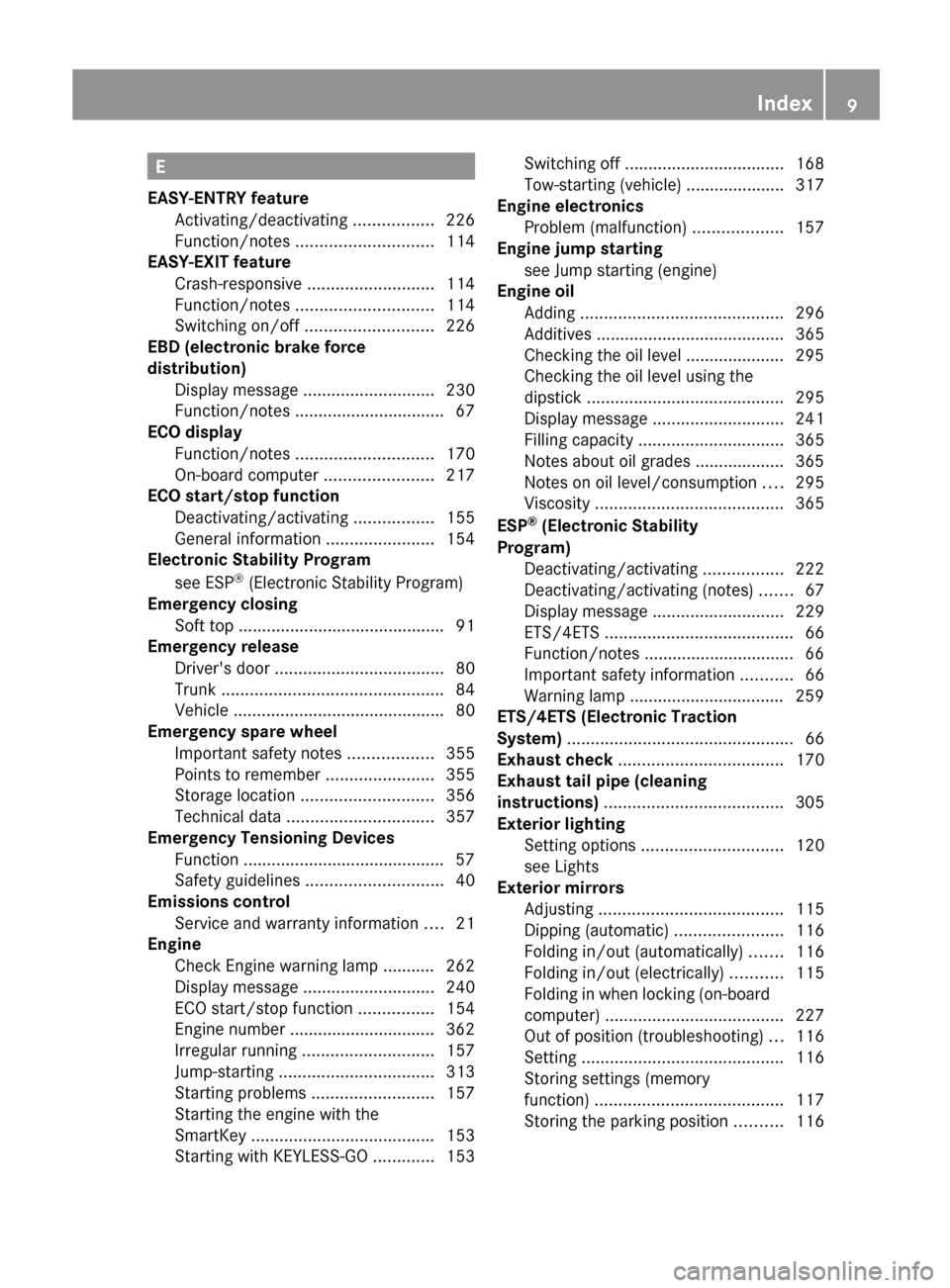
E
EASY-ENTRY feature Activating/deactivating
.................226
Function/notes ............................. 114
EASY-EXIT feature
Crash-responsive ........................... 114
Function/notes ............................. 114
Switching on/off ........................... 226
EBD (electronic brake force
distribution)
Display message ............................ 230
Function/notes ................................ 67
ECO display
Function/notes ............................. 170
On-board computer ....................... 217
ECO start/stop function
Deactivating/activating ................. 155
General information ....................... 154
Electronic Stability Program
see ESP ®
(Electronic Stability Program)
Emergency closing
Soft top ............................................ 91
Emergency release
Driver's door .................................... 80
Trunk ............................................... 84
Vehicle ............................................. 80
Emergency spare wheel
Important safety notes .................. 355
Points to remember .......................355
Storage location ............................ 356
Technical data ............................... 357
Emergency Tensioning Devices
Function ........................................... 57
Safety guidelines ............................. 40
Emissions control
Service and warranty information .... 21
Engine
Check Engine warning lamp ........... 262
Display message ............................ 240
ECO start/stop function ................ 154
Engine number ............................... 362
Irregular running ............................ 157
Jump-starting ................................. 313
Starting problems .......................... 157
Starting the engine with the
SmartKey ....................................... 153
Starting with KEYLESS-GO ............. 153Switching off
.................................. 168
Tow-starting (vehicle) ..................... 317
Engine electronics
Problem (malfunction) ...................157
Engine jump starting
see Jump starting (engine)
Engine oil
Adding ........................................... 296
Additives ........................................ 365
Checking the oil level ..................... 295
Checking the oil level using the
dipstick .......................................... 295
Display message ............................ 241
Filling capacity ............................... 365
Notes about oil grades ................... 365
Notes on oil level/consumption .... 295
Viscosity ........................................ 365
ESP ®
(Electronic Stability
Program) Deactivating/activating ................. 222
Deactivating/activating (notes) ....... 67
Display message ............................ 229
ETS/4ETS ........................................ 66
Function/notes ................................ 66
Important safety information ........... 66
Warning lamp ................................. 259
ETS/4ETS (Electronic Traction
System) ................................................ 66
Exhaust check ................................... 170
Exhaust tail pipe (cleaning
instructions) ...................................... 305
Exterior lighting Setting options .............................. 120
see Lights
Exterior mirrors
Adjusting ....................................... 115
Dipping (automatic) .......................116
Folding in/out (automatically) ....... 116
Folding in/out (electrically) ........... 115
Folding in when locking (on-board
computer) ...................................... 227
Out of position (troubleshooting) ...116
Setting ........................................... 116
Storing settings (memory
function) ........................................ 117
Storing the parking position .......... 116 Index
9
Page 15 of 372
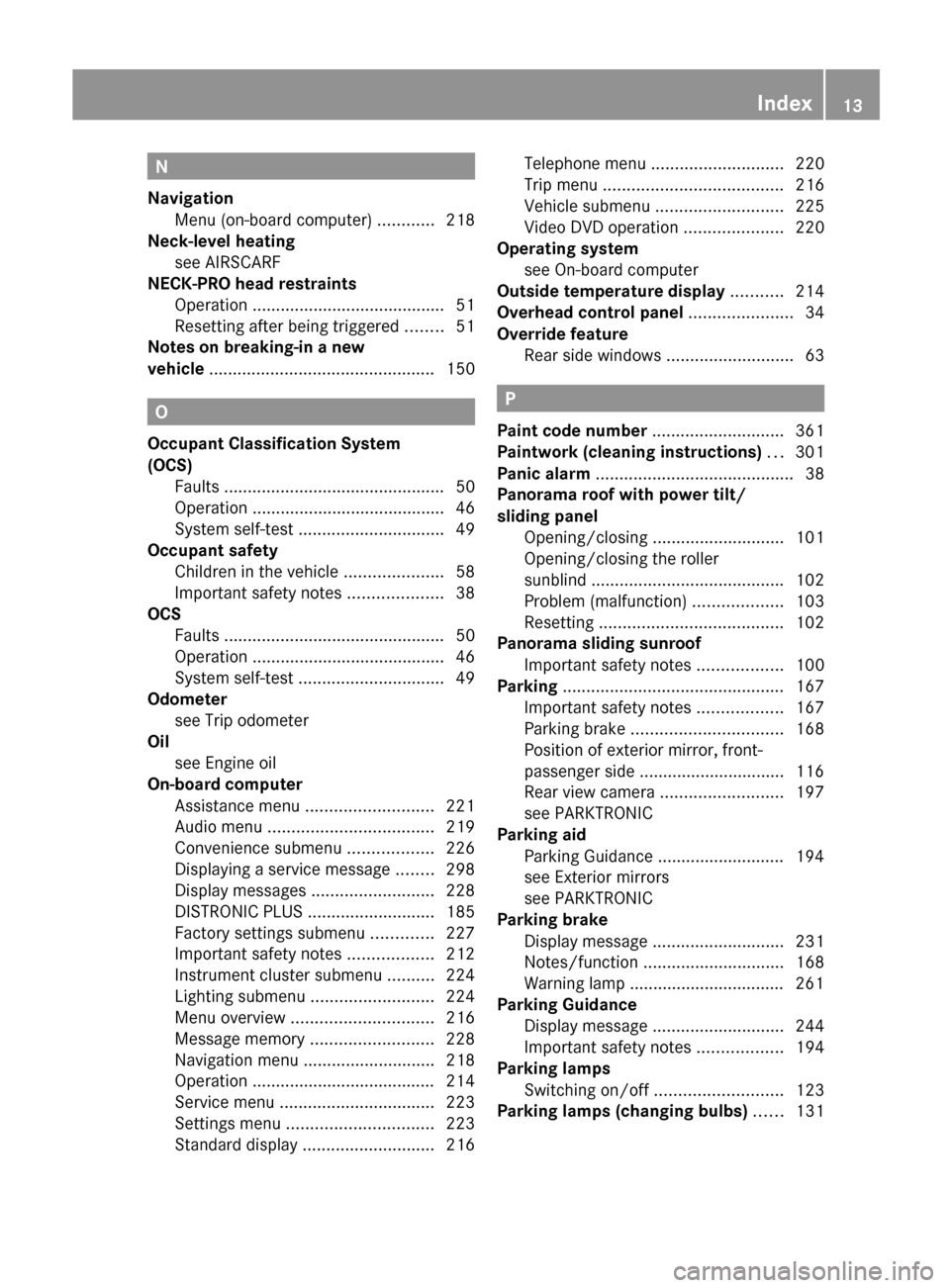
N
Navigation Menu (on-board computer) ............ 218
Neck-level heating
see AIRSCARF
NECK-PRO head restraints
Operation ......................................... 51
Resetting after being triggered ........ 51
Notes on breaking-in a new
vehicle ................................................ 150O
Occupant Classification System
(OCS) Faults ............................................... 50
Operation ......................................... 46
System self-test
............................... 49
Occupant safety
Children in the vehicle .....................58
Important safety notes .................... 38
OCS
Faults ............................................... 50
Operation ......................................... 46
System self-test ............................... 49
Odometer
see Trip odometer
Oil
see Engine oil
On-board computer
Assistance menu ........................... 221
Audio menu ................................... 219
Convenience submenu .................. 226
Displaying a service message ........ 298
Display messages ..........................228
DISTRONIC PLUS ........................... 185
Factory settings submenu ............. 227
Important safety notes .................. 212
Instrument cluster submenu ..........224
Lighting submenu .......................... 224
Menu overview .............................. 216
Message memory .......................... 228
Navigation menu ............................ 218
Operation ....................................... 214
Service menu ................................. 223
Settings menu ............................... 223
Standard display ............................ 216Telephone menu
............................ 220
Trip menu ...................................... 216
Vehicle submenu
........................... 225
Video DVD operation ..................... 220
Operating system
see On-board computer
Outside temperature display ...........214
Overhead control panel ......................34
Override feature Rear side windows ........................... 63 P
Paint code number ............................ 361
Paintwork (cleaning instructions) ...301
Panic alarm .......................................... 38
Panorama roof with power tilt/
sliding panel
Opening/closing ............................ 101
Opening/closing the roller
sunblind ......................................... 102
Problem (malfunction) ...................103
Resetting ....................................... 102
Panorama sliding sunroof
Important safety notes
..................100
Parking ............................................... 167
Important safety notes .................. 167
Parking brake ................................ 168
Position of exterior mirror, front-
passenger side ............................... 116
Rear view camera .......................... 197
see PARKTRONIC
Parking aid
Parking Guidance ........................... 194
see Exterior mirrors
see PARKTRONIC
Parking brake
Display message ............................ 231
Notes/function .............................. 168
Warning lamp ................................. 261
Parking Guidance
Display message ............................ 244
Important safety notes .................. 194
Parking lamps
Switching on/off ........................... 123
Parking lamps (changing bulbs) ......131 Index
13
Page 30 of 372
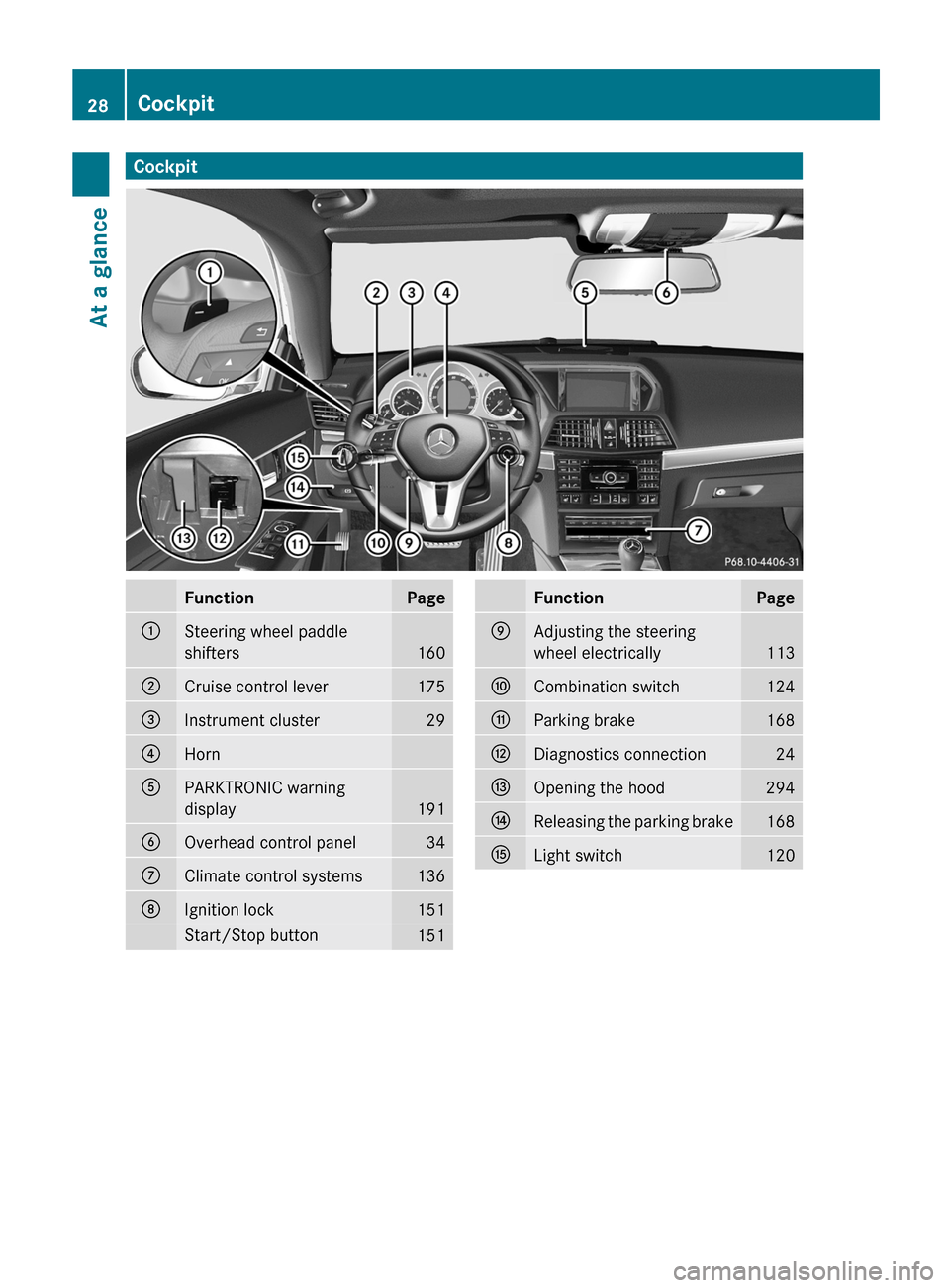
Cockpit
Function Page
:
Steering wheel paddle
shifters
160
;
Cruise control lever 175
=
Instrument cluster 29
?
Horn
A
PARKTRONIC warning
display
191
B
Overhead control panel 34
C
Climate control systems 136
D
Ignition lock 151
Start/Stop button
151 Function Page
E
Adjusting the steering
wheel electrically
113
F
Combination switch 124
G
Parking brake 168
H
Diagnostics connection 24
I
Opening the hood 294
J
Releasing the parking brake 168
K
Light switch 12028
CockpitAt a glance
Page 65 of 372
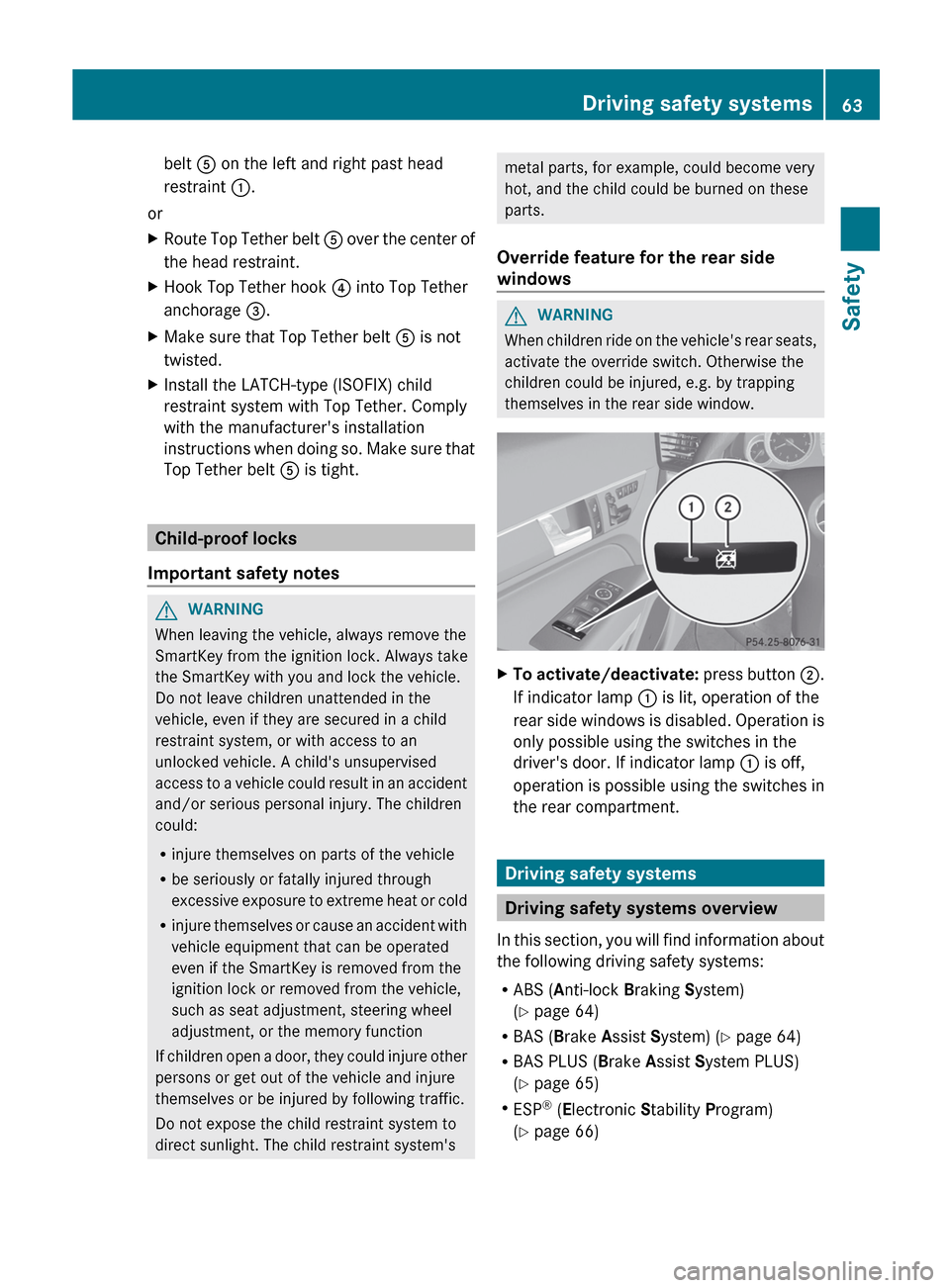
belt A on the left and right past head
restraint :.
or
X Route Top Tether belt A over the center of
the head restraint.
X Hook Top Tether hook ? into Top Tether
anchorage =.
X Make sure that Top Tether belt A is not
twisted.
X Install the LATCH-type (ISOFIX) child
restraint system with Top Tether. Comply
with the manufacturer's installation
instructions
when doing so. Make sure that
Top Tether belt A is tight. Child-proof locks
Important safety notes G
WARNING
When leaving the vehicle, always remove the
SmartKey from the ignition lock. Always take
the SmartKey with you and lock the vehicle.
Do not leave children unattended in the
vehicle, even if they are secured in a child
restraint system, or with access to an
unlocked vehicle. A child's unsupervised
access
to a vehicle could result in an accident
and/or serious personal injury. The children
could:
R injure themselves on parts of the vehicle
R be seriously or fatally injured through
excessive exposure to extreme heat or cold
R injure themselves or cause an accident with
vehicle equipment that can be operated
even if the SmartKey is removed from the
ignition lock or removed from the vehicle,
such as seat adjustment, steering wheel
adjustment, or the memory function
If children open a door, they could injure other
persons or get out of the vehicle and injure
themselves or be injured by following traffic.
Do not expose the child restraint system to
direct sunlight. The child restraint system's metal parts, for example, could become very
hot, and the child could be burned on these
parts.
Override feature for the rear side
windows G
WARNING
When children ride on the vehicle's rear seats,
activate the override switch. Otherwise the
children could be injured, e.g. by trapping
themselves in the rear side window. X
To activate/deactivate: press
button ;.
If indicator lamp : is lit, operation of the
rear side windows is disabled. Operation is
only possible using the switches in the
driver's door. If indicator lamp : is off,
operation is possible using the switches in
the rear compartment. Driving safety systems
Driving safety systems overview
In
this section, you will find information about
the following driving safety systems:
R ABS ( Anti-lock Braking System)
(Y page 64)
R BAS ( Brake Assist System) ( Y page 64)
R BAS PLUS ( Brake Assist System PLUS)
(Y page 65)
R ESP ®
(Electronic Stability Program)
(Y page 66) Driving safety systems
63
Safety Z
Page 66 of 372
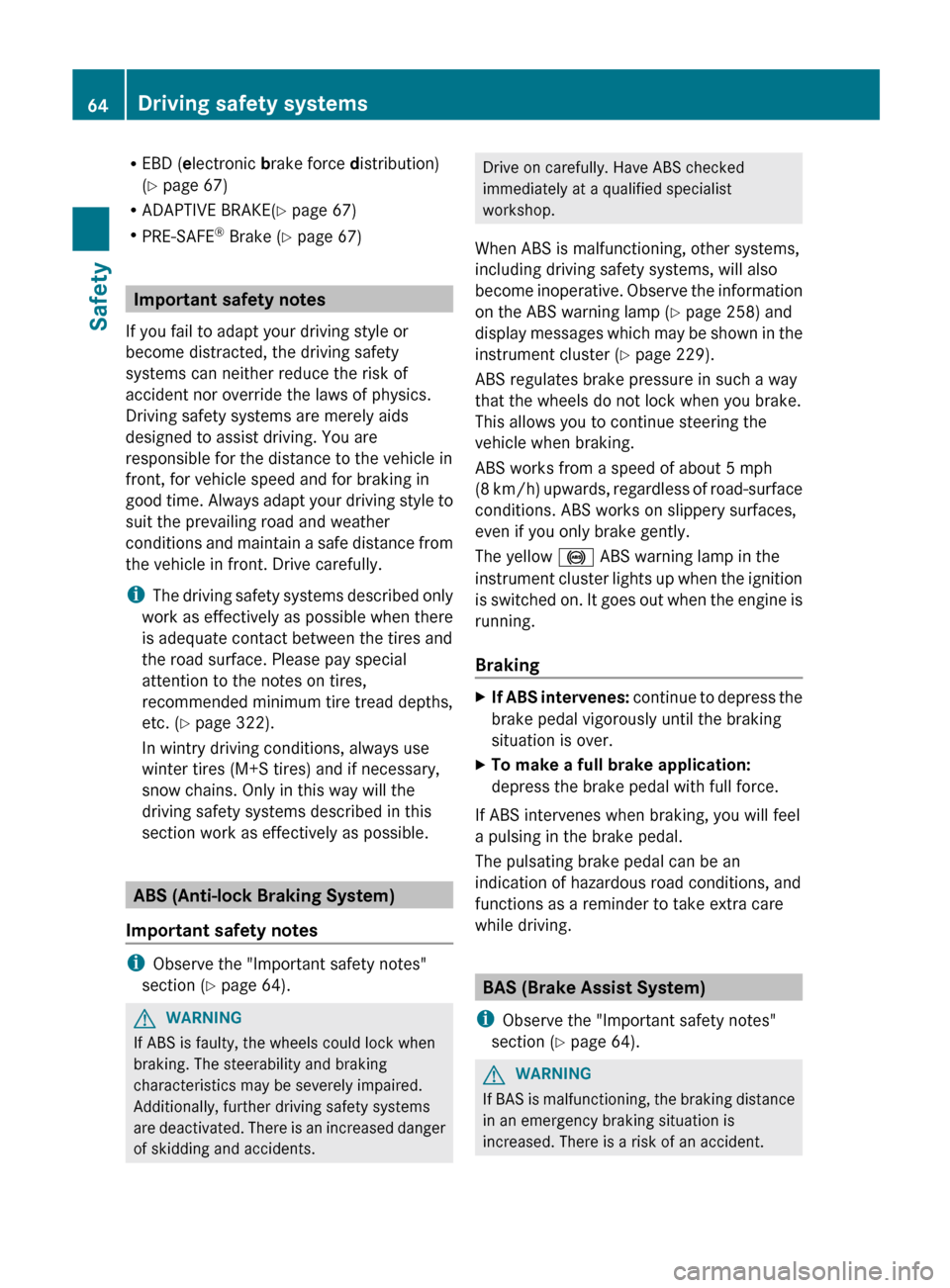
R
EBD ( electronic brake force distribution)
(Y page 67)
R ADAPTIVE BRAKE
(Y page 67)
R PRE-SAFE ®
Brake (Y page 67) Important safety notes
If you fail to adapt your driving style or
become distracted, the driving safety
systems can neither reduce the risk of
accident nor override the laws of physics.
Driving safety systems are merely aids
designed to assist driving. You are
responsible for the distance to the vehicle in
front, for vehicle speed and for braking in
good
time. Always adapt your driving style to
suit the prevailing road and weather
conditions and maintain a safe distance from
the vehicle in front. Drive carefully.
i The driving safety systems described only
work as effectively as possible when there
is adequate contact between the tires and
the road surface. Please pay special
attention to the notes on tires,
recommended minimum tire tread depths,
etc. (Y page 322).
In wintry driving conditions, always use
winter tires (M+S tires) and if necessary,
snow chains. Only in this way will the
driving safety systems described in this
section work as effectively as possible. ABS (Anti-lock Braking System)
Important safety notes i
Observe the "Important safety notes"
section ( Y page 64).G
WARNING
If ABS is faulty, the wheels could lock when
braking. The steerability and braking
characteristics may be severely impaired.
Additionally, further driving safety systems
are
deactivated. There is an increased danger
of skidding and accidents. Drive on carefully. Have ABS checked
immediately at a qualified specialist
workshop.
When ABS is malfunctioning, other systems,
including driving safety systems, will also
become
inoperative. Observe the information
on the ABS warning lamp ( Y page 258) and
display messages which may be shown in the
instrument cluster (Y page 229).
ABS regulates brake pressure in such a way
that the wheels do not lock when you brake.
This allows you to continue steering the
vehicle when braking.
ABS works from a speed of about 5 mph
(8 km/h) upwards, regardless of road-surface
conditions. ABS works on slippery surfaces,
even if you only brake gently.
The yellow ! ABS warning lamp in the
instrument cluster lights up when the ignition
is switched on. It goes out when the engine is
running.
Braking X
If ABS intervenes:
continue to depress the
brake pedal vigorously until the braking
situation is over.
X To make a full brake application:
depress the brake pedal with full force.
If ABS intervenes when braking, you will feel
a pulsing in the brake pedal.
The pulsating brake pedal can be an
indication of hazardous road conditions, and
functions as a reminder to take extra care
while driving. BAS (Brake Assist System)
i Observe the "Important safety notes"
section ( Y page 64). G
WARNING
If BAS is malfunctioning, the braking distance
in an emergency braking situation is
increased. There is a risk of an accident. 64
Driving safety systems
Safety
Page 68 of 372
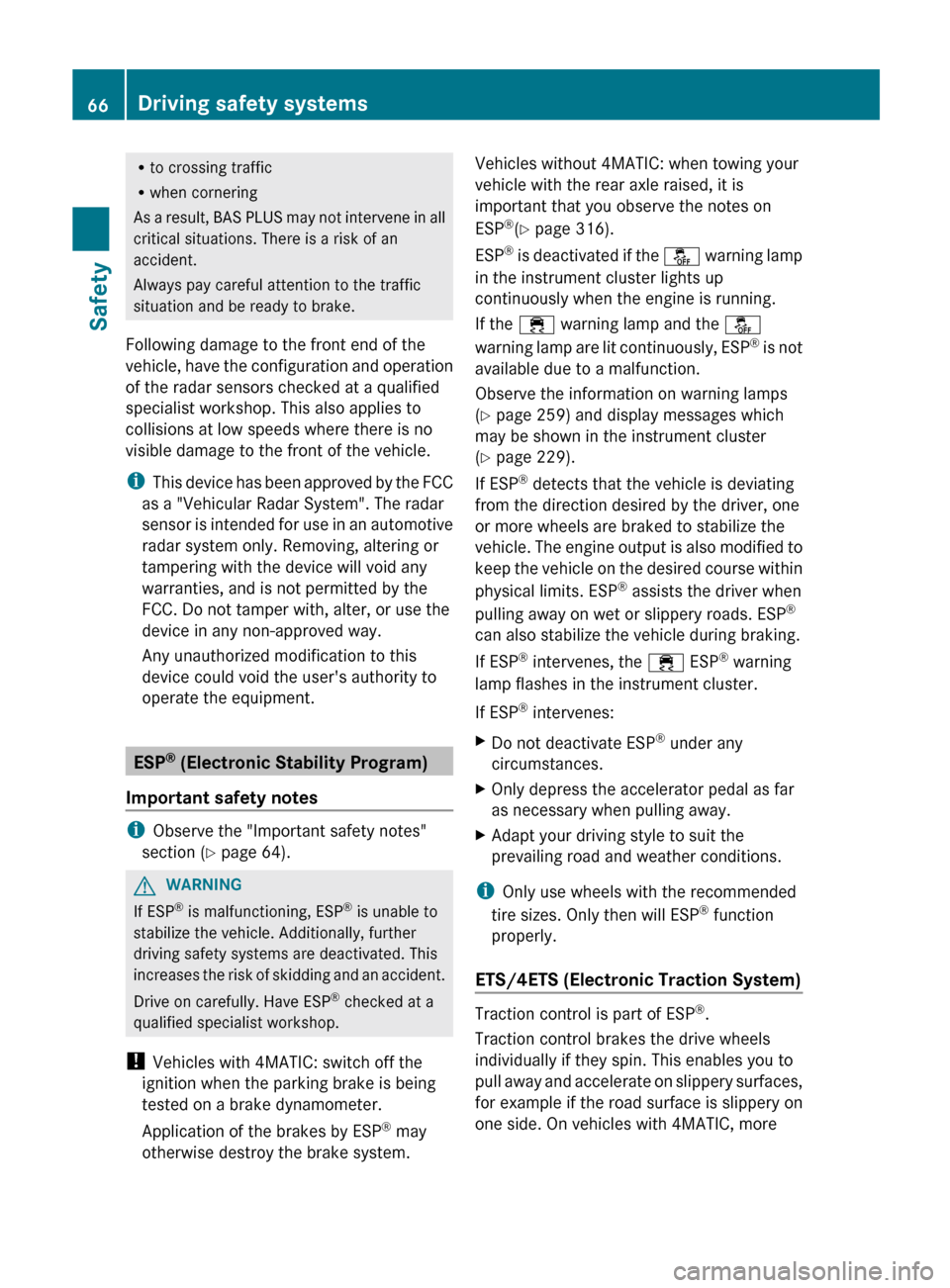
R
to crossing traffic
R when cornering
As
a result, BAS PLUS may not intervene in all
critical situations. There is a risk of an
accident.
Always pay careful attention to the traffic
situation and be ready to brake.
Following damage to the front end of the
vehicle, have the configuration and operation
of the radar sensors checked at a qualified
specialist workshop. This also applies to
collisions at low speeds where there is no
visible damage to the front of the vehicle.
i This device has been approved by the FCC
as a "Vehicular Radar System". The radar
sensor is intended for use in an automotive
radar system only. Removing, altering or
tampering with the device will void any
warranties, and is not permitted by the
FCC. Do not tamper with, alter, or use the
device in any non-approved way.
Any unauthorized modification to this
device could void the user's authority to
operate the equipment. ESP
®
(Electronic Stability Program)
Important safety notes i
Observe the "Important safety notes"
section ( Y page 64).G
WARNING
If ESP ®
is malfunctioning, ESP ®
is unable to
stabilize the vehicle. Additionally, further
driving safety systems are deactivated. This
increases
the risk of skidding and an accident.
Drive on carefully. Have ESP ®
checked at a
qualified specialist workshop.
! Vehicles with 4MATIC: switch off the
ignition when the parking brake is being
tested on a brake dynamometer.
Application of the brakes by ESP ®
may
otherwise destroy the brake system. Vehicles without 4MATIC: when towing your
vehicle with the rear axle raised, it is
important that you observe the notes on
ESP
®
(Y page 316).
ESP ®
is deactivated if the å warning lamp
in the instrument cluster lights up
continuously when the engine is running.
If the ÷ warning lamp and the å
warning lamp are lit continuously, ESP ®
is not
available due to a malfunction.
Observe the information on warning lamps
(Y page 259) and display messages which
may be shown in the instrument cluster
(Y page 229).
If ESP ®
detects that the vehicle is deviating
from the direction desired by the driver, one
or more wheels are braked to stabilize the
vehicle. The engine output is also modified to
keep the vehicle on the desired course within
physical limits. ESP ®
assists the driver when
pulling away on wet or slippery roads. ESP ®
can also stabilize the vehicle during braking.
If ESP ®
intervenes, the ÷ ESP®
warning
lamp flashes in the instrument cluster.
If ESP ®
intervenes:
X Do not deactivate ESP ®
under any
circumstances.
X Only depress the accelerator pedal as far
as necessary when pulling away.
X Adapt your driving style to suit the
prevailing road and weather conditions.
i Only use wheels with the recommended
tire sizes. Only then will ESP ®
function
properly.
ETS/4ETS (Electronic Traction System) Traction control is part of ESP
®
.
Traction control brakes the drive wheels
individually if they spin. This enables you to
pull
away and accelerate on slippery surfaces,
for example if the road surface is slippery on
one side. On vehicles with 4MATIC, more 66
Driving safety systems
Safety
Page 69 of 372
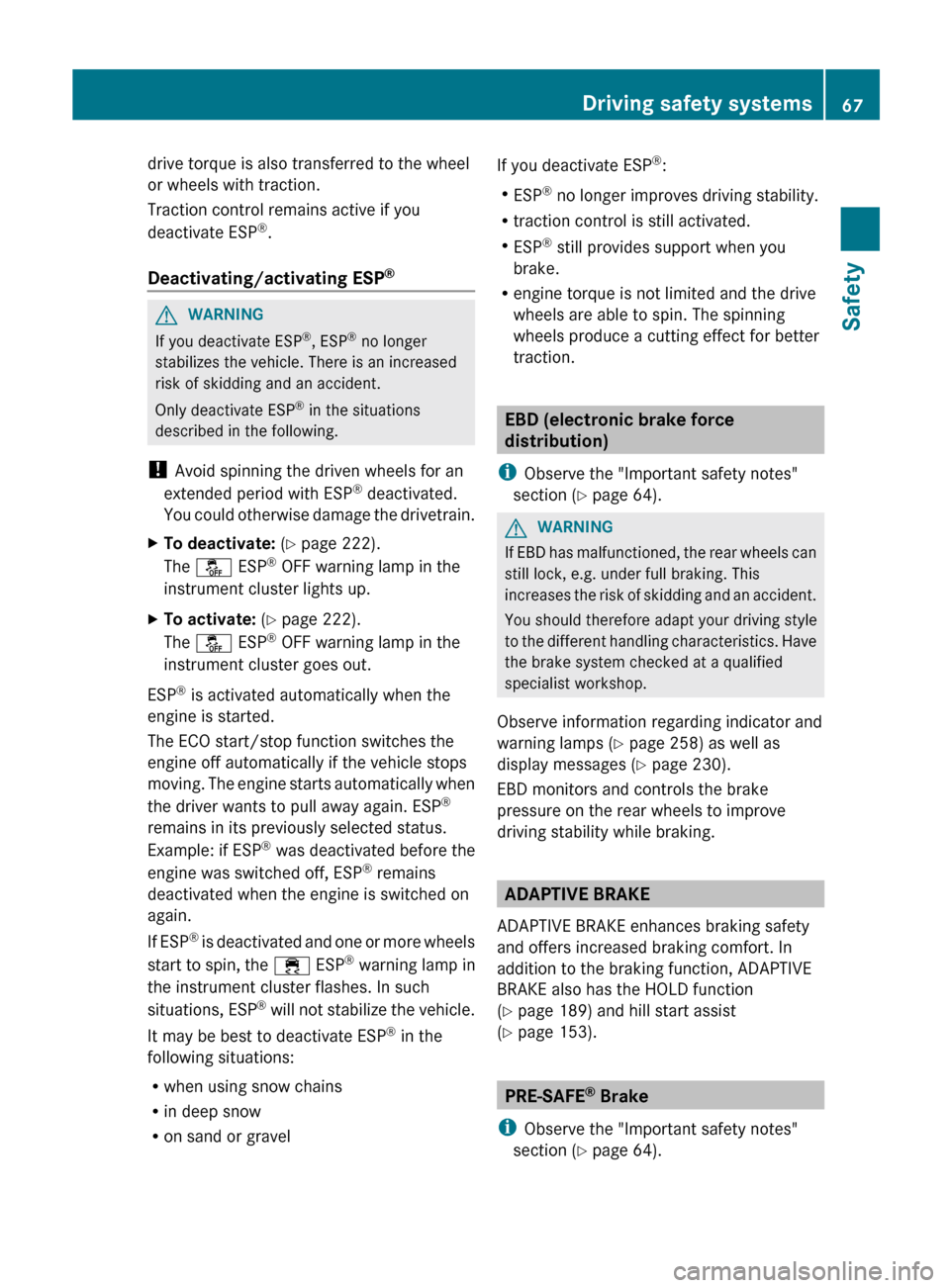
drive torque is also transferred to the wheel
or wheels with traction.
Traction control remains active if you
deactivate ESP
®
.
Deactivating/activating ESP ®G
WARNING
If you deactivate ESP ®
, ESP ®
no longer
stabilizes the vehicle. There is an increased
risk of skidding and an accident.
Only deactivate ESP ®
in the situations
described in the following.
! Avoid spinning the driven wheels for an
extended period with ESP ®
deactivated.
You
could otherwise damage the drivetrain.
X To deactivate: (Y page 222).
The å ESP ®
OFF warning lamp in the
instrument cluster lights up.
X To activate: (Y page 222).
The å ESP ®
OFF warning lamp in the
instrument cluster goes out.
ESP ®
is activated automatically when the
engine is started.
The ECO start/stop function switches the
engine off automatically if the vehicle stops
moving.
The engine starts automatically when
the driver wants to pull away again. ESP ®
remains in its previously selected status.
Example: if ESP ®
was deactivated before the
engine was switched off, ESP ®
remains
deactivated when the engine is switched on
again.
If ESP ®
is deactivated and one or more wheels
start to spin, the ÷ ESP®
warning lamp in
the instrument cluster flashes. In such
situations, ESP ®
will not stabilize the vehicle.
It may be best to deactivate ESP ®
in the
following situations:
R when using snow chains
R in deep snow
R on sand or gravel If you deactivate ESP
®
:
R ESP ®
no longer improves driving stability.
R traction control is still activated.
R ESP ®
still provides support when you
brake.
R engine torque is not limited and the drive
wheels are able to spin. The spinning
wheels produce a cutting effect for better
traction. EBD (electronic brake force
distribution)
i Observe the "Important safety notes"
section ( Y page 64). G
WARNING
If EBD has malfunctioned, the rear wheels can
still lock, e.g. under full braking. This
increases
the risk of skidding and an accident.
You should therefore adapt your driving style
to the different handling characteristics. Have
the brake system checked at a qualified
specialist workshop.
Observe information regarding indicator and
warning lamps ( Y page 258) as well as
display messages ( Y page 230).
EBD monitors and controls the brake
pressure on the rear wheels to improve
driving stability while braking. ADAPTIVE BRAKE
ADAPTIVE BRAKE enhances braking safety
and offers increased braking comfort. In
addition to the braking function, ADAPTIVE
BRAKE also has the HOLD function
(Y page 189) and hill start assist
(Y page 153). PRE-SAFE
®
Brake
i Observe the "Important safety notes"
section ( Y page 64). Driving safety systems
67
Safety Z
Page 70 of 372
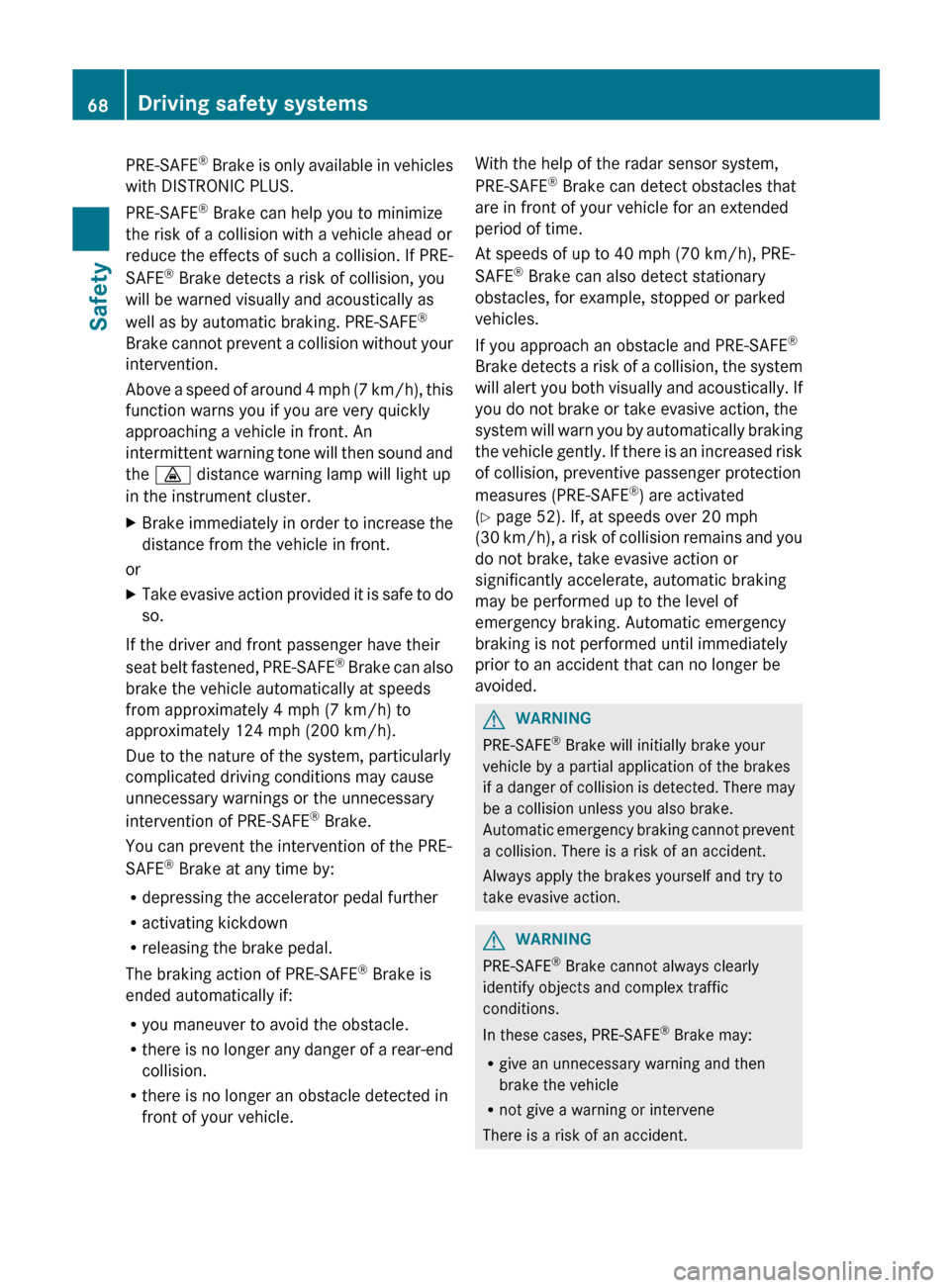
PRE-SAFE
®
Brake is only available in vehicles
with DISTRONIC PLUS.
PRE-SAFE ®
Brake can help you to minimize
the risk of a collision with a vehicle ahead or
reduce the effects of such a collision. If PRE-
SAFE ®
Brake detects a risk of collision, you
will be warned visually and acoustically as
well as by automatic braking. PRE-SAFE ®
Brake cannot prevent a collision without your
intervention.
Above a speed of around 4 mph (7 km/h), this
function warns you if you are very quickly
approaching a vehicle in front. An
intermittent warning tone will then sound and
the · distance warning lamp will light up
in the instrument cluster.
X Brake immediately in order to increase the
distance from the vehicle in front.
or
X Take evasive action provided it is safe to do
so.
If the driver and front passenger have their
seat
belt fastened, PRE-SAFE ®
Brake can also
brake the vehicle automatically at speeds
from approximately 4 mph (7 km/h) to
approximately 124 mph (200 km/h).
Due to the nature of the system, particularly
complicated driving conditions may cause
unnecessary warnings or the unnecessary
intervention of PRE-SAFE ®
Brake.
You can prevent the intervention of the PRE-
SAFE ®
Brake at any time by:
R depressing the accelerator pedal further
R activating kickdown
R releasing the brake pedal.
The braking action of PRE-SAFE ®
Brake is
ended automatically if:
R you maneuver to avoid the obstacle.
R there is no longer any danger of a rear-end
collision.
R there is no longer an obstacle detected in
front of your vehicle. With the help of the radar sensor system,
PRE-SAFE
®
Brake can detect obstacles that
are in front of your vehicle for an extended
period of time.
At speeds of up to 40 mph (70 km/h
), PRE-
SAFE ®
Brake can also detect stationary
obstacles, for example, stopped or parked
vehicles.
If you approach an obstacle and PRE-SAFE ®
Brake detects a risk of a collision, the system
will alert you both visually and acoustically. If
you do not brake or take evasive action, the
system will warn you by automatically braking
the vehicle gently. If there is an increased risk
of collision, preventive passenger protection
measures (PRE-SAFE ®
) are activated
(Y page 52). If, at speeds over 20 mph
(30 km/h), a risk of collision remains and you
do not brake, take evasive action or
significantly accelerate, automatic braking
may be performed up to the level of
emergency braking. Automatic emergency
braking is not performed until immediately
prior to an accident that can no longer be
avoided. G
WARNING
PRE-SAFE ®
Brake will initially brake your
vehicle by a partial application of the brakes
if
a danger of collision is detected. There may
be a collision unless you also brake.
Automatic emergency braking cannot prevent
a collision. There is a risk of an accident.
Always apply the brakes yourself and try to
take evasive action. G
WARNING
PRE-SAFE ®
Brake cannot always clearly
identify objects and complex traffic
conditions.
In these cases, PRE-SAFE ®
Brake may:
R give an unnecessary warning and then
brake the vehicle
R not give a warning or intervene
There is a risk of an accident. 68
Driving safety systems
Safety